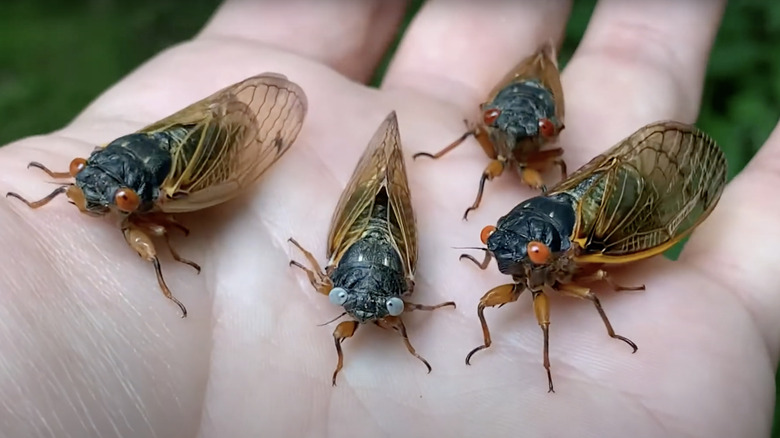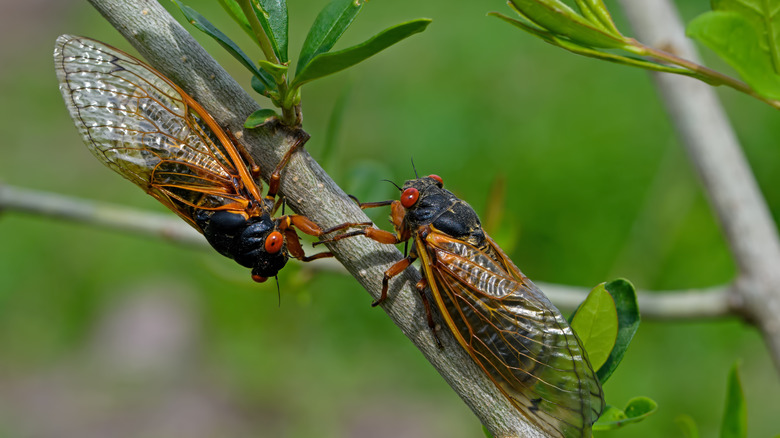What It Means If You Spot A Rare Blue-Eyed Cicada In Your Yard
As two separate broods emerge across parts of the United States, 2024 will be the year of the cicada — and if you happen to see one of these bugs with blue eyes, you've caught something special. Brood XIX, which emerges every 13 years, and Brood XIII, which comes out of the ground every 17 years, will both emerge this year for the first time since 1803. Since the insects started appearing in parts of Illinois this month, a few female Magicicada cassini cicadas – one of three species in the 17-year brood –have been spotted with blue eyes.
Most cicadas have red eyes, and while seeing a blue-eyed one might not seem so strange, Floyd W. Shockley, collections manager of the Department of Entomology at the Smithsonian Institute, told the Associated Press that there's no way to know how often this bug truly appears in nature. "It is impossible to estimate how rare since you'd have to collect all the cicadas to know what percentage of the population had the blue eye mutation," he said. If you see one of these rare cicadas in your yard, there is a chance you may never spot one again, and you might want to take pictures or get into contact with local entomologists.
Rare blue-eyed cicadas are capturing attention
One of the blue-eyed cicadas this year was seen in Lisle, Illinois, by a visitor at The Morton Arboretum and was released after being viewed. Another was found by children in a family backyard in Wheaton, Illinois, a suburb of Chicago. Since then, the latter has been donated to Chicago's Field Museum and is the first blue-eyed cicada at the museum. Jim Louderman, a collections assistant with the museum, explained how special this occurrence was in a press release. "I have been in Chicago for five periodical Cicada emergences of our Brood XIII, and this is the first blue-eyed cicada I have seen," he said. "I have also seen two emergences of Brood X in Indiana and two emergences of Brood XIX in Central Illinois. These rare insect emergences are always infertile and can not have offspring, which is why they remain so rare."
In 2021, another one of the unique insects was found in West Harrison, Indiana. Though there have been some online rumors that finding a blue-eyed cicada could lead to money from collectors, this is likely untrue. In its press release, the Chicago Field Museum states that those who find these rare insects can upload photos of them to an app, Cicada Safari, to help scientists who study them. While these bugs are not dangerous to people or pets, they can harm vegetation, so it's important to learn how to know cicadas are coming and how to protect your plants.
Dealing with the 2024 cicada emergence
The broods emerging right now will be seen mostly in the eastern United States, with brood XIX in states from Missouri to Virginia as well as southern portions of Illinois and brood XIII in parts of Michigan, Iowa, Wisconsin, Indiana, and Illinois. It may be interesting to watch the hoards of cicadas and search for any rare ones with blue eyes, but it's also important to make sure your trees are prepared for these insects. Cicadas can cause varying degrees of damage to trees and plants. While some younger trees may die from cicada activity, older and bigger trees might only have some harmed branches. This occurs because female cicadas will carve out grooves in the tree's branches to lay their eggs.
You can help prevent your trees from being harmed by placing netting over them, though this must be done before the cicadas start coming out of the ground. This typically occurs when soil temperatures are around 64 degrees Fahrenheit. You may also search for what is attracting noisy cicadas to your yard to find ways to prevent their damage. Otherwise, keep your eyes peeled for any of these bugs that might have blue eyes rather than red for a special sight.

